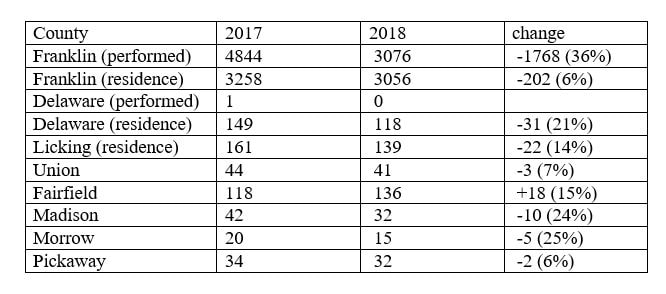The abortion rate in Central Ohio has significantly dropped from 4844 in 2017 to 3706 in 2018.
Note: in the e-news-version of this story, a typo in this article was produced throughout. The abortion rate declined by 25%, not 36%. Consider that our goal for next year! - BV.
If you have not heard, Ohio’s abortion statistics report was issued today. Each fall, Ohio’s Department of Health issues abortion statistics for the year prior. The statistics look at various demographic information like where the abortion was performed and where the mother who had the abortion resides. It tracks the method of abortion – both distinguishing between surgical and non surgical abortions but also breaking down types of procedures within the larger subset. It also looks at things like the mother’s race and ethnicity, the number of reported prior abortions or live births, her education, her age, and her marital status. You can review a copy of the 2018 Ohio Abortion Statistics online here (warning – it is a larger pdf file).
Earlier this month, the pro-abortion Guttmacher Institute released a report detailing a national decline in the number of abortions over the past seven years. The abortion advocacy research organization argues that the proliferation of pro-life laws does not explain the reduction in total abortions but also indicates that some of the decrease is due to abortion restrictions passed by various states.
In context, the report issued by Ohio today shows that the local abortion rate has fallen by nearly 25% and that abortions in Ohio have hit another all-time low. In all, the number of abortions statewide decreased from 20,893 abortions in 2017 to 20,425 in 2018.
Statewide, the reduction in abortion is largely among women aged 19 or younger. The majority of women having abortions continue to be unmarried, with 79% reporting that they are single, divorced, separated, or widowed. Approximately 10% did not disclose their marital status and about 10% reported being married. Among the women who reported their race, about 48% were white, about 44% were African American, about 6% were Hispanic, and about 4% were Asian/Pacific Islander. Another 4% reported multiple ethnicity.
The Ohio abortion statistics report tracks abortion by two metrics. One is by the county in which the abortion was performed and the other is by where the mother reports that she resides.
There are a few notable things about the 2018 abortions locally to consider. At the beginning of 2018, Franklin County had two abortion clinics operating. Both performed both surgical and medical/chemical abortions. The clinics were Founders (1243 E Broad Street) and Planned Parenthood (3255 E Main). In June, we learned that Founders had closed its doors, likely due to a dispute between the physicians that owned the clinic and the management that operated it. For several months in 2018, Franklin County only had one operating abortion clinic. In the summer, the management team (formerly of Founder’s) opened a new abortion clinic on the north side of Columbus. The clinic did not obtain a license to perform surgical abortions, meaning that it offered chemical abortions only. This raised the number of clinics open back to two, with one offering surgical and chemical and one offering chemical only. In mid-autumn, Founder’s resumed operations, but subsequently their founding physician lost his license to practice medicine and the clinic relinquished its surgical license. It remains open, offering chemical abortions only, raising the total number of abortion clinics today to three. While most counties in central Ohio saw a drop in abortions, the temporary reduction in clinics and their subsequently sending patients to partner clinics in Montgomery and Lucas Counties for surgical abortions may account for a significant portion of the decline, and undoubtedly accounts for the steep increase in the use of medical abortions. It is worth noting that in 2018, two abortions were performed locally using methotrexate, something that was not previously done here (and is not frequently used throughout the state).
Several years ago, GCRTL started reporting on the abortion rate locally. Last year, we averaged about 13 babies lost to abortion each day. Locally, we now see just a little over 10 babies on average each day. Statewide, we have been steady at 57 babies each day for approximately three years. That figure has dropped to about 56.
While looking at the data provides an interesting snapshot into what is occurring in our neighborhood, it is only useful to the extent that we have adequate resources to go into the community with programs like sidewalk ministry, education, and referrals. It is not too late for us to reduce the number of abortions in 2019, but we need your help. To join our prayer program, visit www.gcrtl.org/pray, or sign up today to join our 40 Days for Life vigil (www.gcrtl.org/40-days-for-life). We also need to raise another $30,000 through the end of the year. If you can donate to make that happen, you can be taken to our secure giving partner to donate here. If you would like to bring one of our educational programs to your church, school, or group, you can also email us, here.

 RSS Feed
RSS Feed
